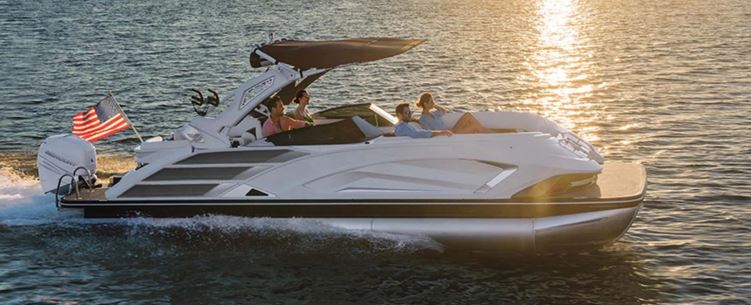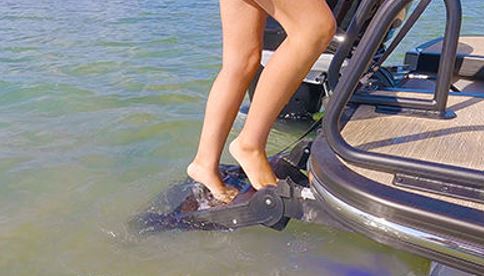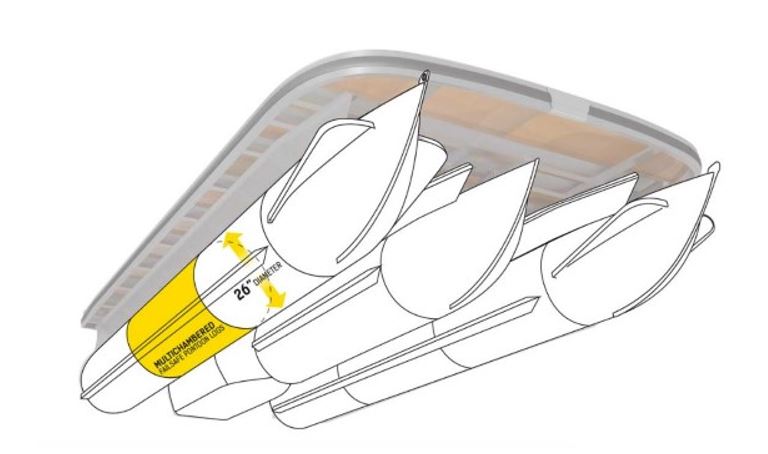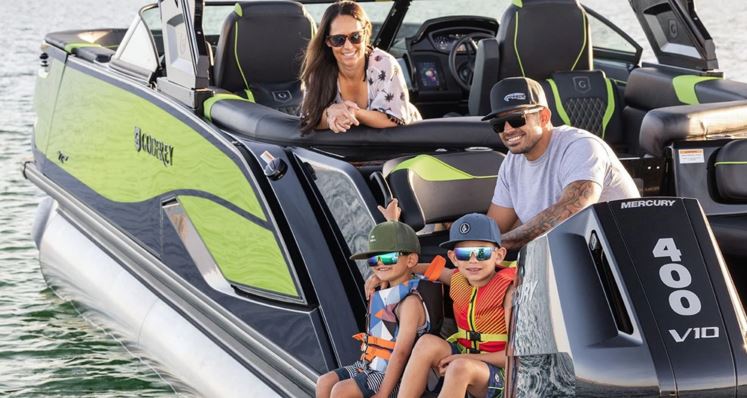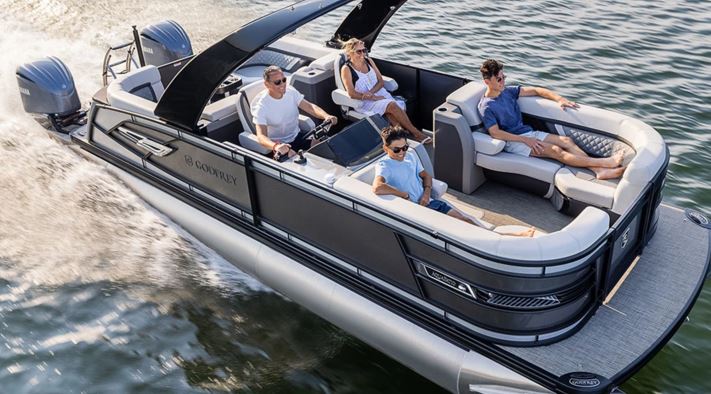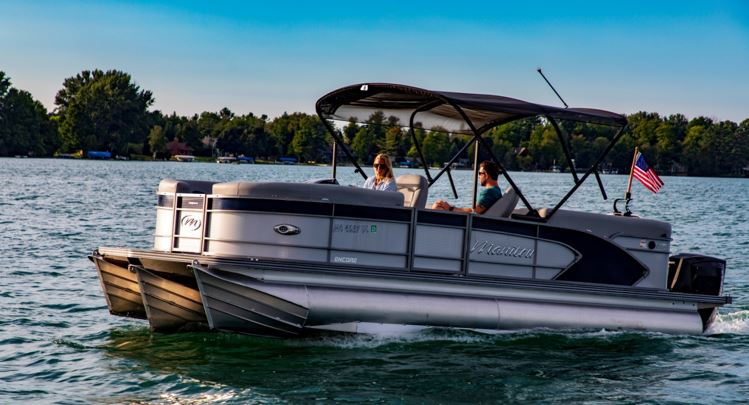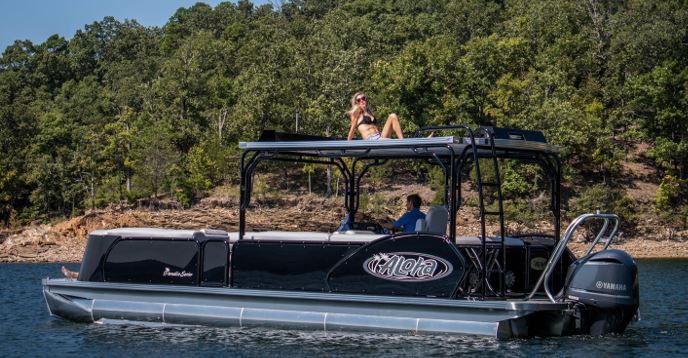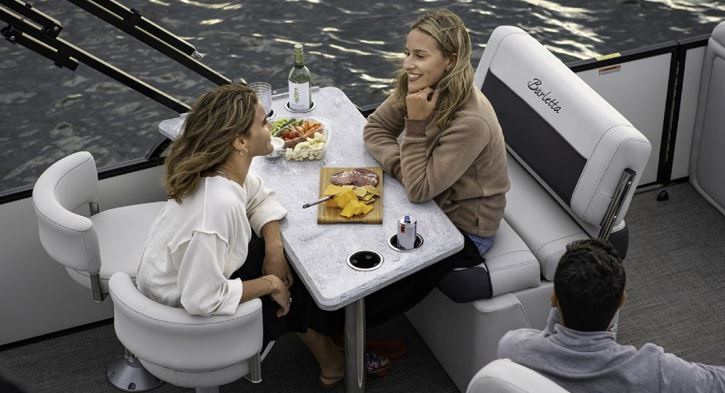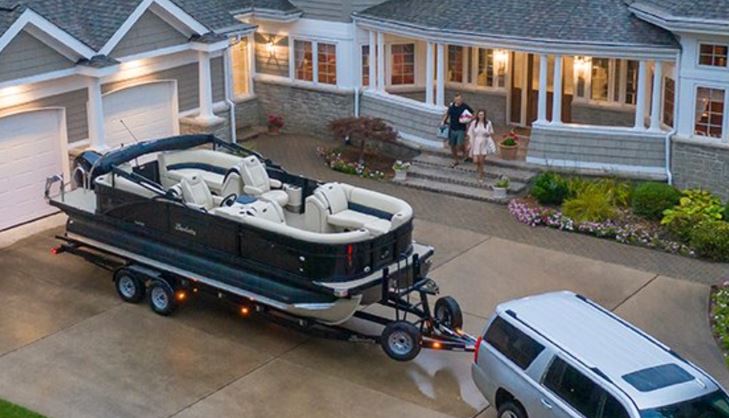12 Tips for Choosing a Pontoon Boat, Part II
You can’t go far wrong buying most of today’s offerings in the pontoon boat market, which offer more space, speed, convenience and style than ever before. But there are a number of features that can make your choice a lot more enjoyable—here are some additional tips on what to look for.
7. Re-Boarding Ladder
You’ll want to swim and probably tube or water-ski behind your pontoon boat. That and the possibility of someone falling overboard—as well as the American Boat and Yacht Council (ABYC) guidelines for re-boarding ladders to extend at least 22” (0.56 m) below the waterline—mean that a lengthy and robust ladder that’s easy to use is an essential feature all of us should look for.
Wide, flat steps and handrails make re-boarding easier in bare feet. Not everyone is an agile 150-lb. (68 kg) teenager and having a heavy-duty ladder makes it easier for a larger number of people to use it. There is a great difference in the ladder and re-boarding apparatus from one boat builder to the next. Check them out before buying.
8. Two Pontoons or Three?
Recreational pontoon boats had just two pontoons in the beginning, but 20 years or so ago builders started introducing tri-toons. Tri-toons cost more but they have many advantages when it comes to load capacity and speed.
Twin-pontoon boats rarely can plane and generally are design for slower displacement speeds. They are fine for cruising around the lake at sedate speeds and to provide a stable platform for swimming and entertaining. Putting large engines on a twin-toon boat will make it go marginally faster, but generally, it will not provide satisfactory performance for tow sports.
Tri-toons, if properly powered and propped, can go as fast as most sport boats and can get on plane fast. These boats make good platforms for tow ports, but don’t expect them to make big wakes for wakeboarding. However, they are fine for waterskiing and tubing.
Some tri-toons have a larger center pontoon, giving the boat lift and cornering performance similar to a monohull as well as improving speed and fuel efficiency.
9. Match Outboard Engines to the Task
Twin-toon boats require little power, depending on the load and the speed required. Outboard engines of 50- or 60-hp can generally push an 18’ to 20’ (5.4-6.0 m) twin toon at 15 to 18 mph. That is about as fast as they will go and putting a larger engine on and winding it up will make the boat go a little faster, but considerably increase fuel consumption.
For those who want to go fast with lots of guests or tow skiers and tubers, a tri-toon with a 150-hp outboard or larger does the job. Larger tri-toons can easily handle 300-hp engines and some models now handle two large outboards. We have even tested a 32’ (9.75 m) tri-toon with three large outboard engines. Of course, all that horsepower puts fuel consumption into a whole other level, but it’s available for those who have the need for speed.
High Torque Matters
All pontoon boats are hard to get on plane and this places a premium on outboard engines that have high torque in the low RPM ranges. Four-blade props will probably provide the best take-off performance for nearly any pontoon boat application, and you may have to tweak the pitch to get the best combination of take-off and mid-range economy.
10. Pontoon Tube Size Choices
Pontoon boats obviously get their buoyancy from the pontoons, and the greater their diameter generally the more satisfying the experience. Pontoons with a 23” (0.58 m) diameter are about the smallest diameter we see and they are generally on smaller boats, those under 20’ (6.0 m).
More typically we see 24”-25” (0.6-0.63 m) pontoons on both twin-toon and tri-toon vessels. Occasionally, on some of the more expensive boats, we will see 26” (0.66 m) toons.
In some tri-toon models the center toon is of a greater diameter. This aids in turning with a slight inward lean, as well as giving the boat the buoyancy it needs to go fast. The greater the size of the diameter of the pontoon the more stable the boat will be and the faster it will go. All pontoons should have three or four air-tight chambers. This not only gives the tubes more integrity but also provides a measure of safety should a chamber be punctured.
11. Bimini Tops Are a “Must Have”
Virtually all pontoon boats have a Bimini top available either standard or as an option. They are important to the guests’ comfort and we recommend getting the biggest one available. Look for one that is easy to deploy. Some boats even have power Bimini tops. Make sure to operate the Bimini prior to purchase as some can be aggravating to set and put in their boot when it is time to call it a day.
All boats should have canvas to protect the upholstery from UV degradation to say nothing of the soot and grit that might be in the air. Those living near highways will be familiar with the light rain of tire rubber and unburned diesel carbon that settles on everything. While a playpen-style full cover might seem like a good idea (they are certainly the cheapest), individual seat covers are much easier to deal with. Unless a boat is stored in an area where the deck can get covered in leaves or pine needles, go with seat covers.
12. Comfort Amenities Are Important
Boaters should think about family and guests and ask themselves how they can get the most enjoyment out of the boat they plan to buy. Heading our list of welcome amenities is the changing curtain so that guests can wiggle out of wet bathing suits and get into dry cloths. Most builders make these available as an option, if not standard. Also, a Porta-Potti can be fitted in some of them, but not all.
Other convenience items worth mentioning are portable cup holders that sit on the seats and pedestal tables. Generally, the pedestal tables are small and are limited to drinks and snacks. Those wanting to serve dinner al fresco will need to find a boat with a proper table and a grill.
These days builders of pontoon boats are providing more and more amenities. Sinks, running water, refrigerators, gas grills, and more are available in the premium-level pontoon boats.
What They Cost
You’ll quickly see that picking every amenity and feature moves the family pontoon from an affordable, easy to tow and cheap-to-store utility boat into a lux-class mini-yacht, with pricing to match.
The Bass Tracker 18 DLX, for example, goes for about $27,000 with a 60 hp Mercury outboard and no trailer.
A Harris Crowne SL 250 completely loaded and powered by a 400-hp Mercury will be almost 10 times that amount. Add twin outboards, electronics and other features and the price climbs even higher—we’ve seen some close to $400,000. So whatever your budget, you can probably find a sweet spot, a pontoon that’s big enough and with enough features to please your whole crew, and yet that falls within your disposable income level.
If You Need a Trailer
Many pontoon boats are permanently located on a hoist in back of their owners’ lakefront home so no trailer is needed. However, most of us don’t live on the water. And even if you do, a trailer makes it possible to visit distant waters and to take your boat along on vacations, so for many the added investment is worth it.
Pontoon boat trailers typically have two v-bunks for a two-pontoon model and three v-bunks for a three bunk model. They’re designed for drive-on use, with the frame positioned low so that the boat can float on and off when the trailer is put into the water to the right depth. Single-axle designs are adequate for pontoon boats to 20’, while larger models with larger motors are typically matched with double axles.
As with all trailers, painted steel is the least expensive but also the most vulnerable to rust and corrosion. Better are galvanized steel or lightweight aluminum, both of which are corrosion proof and promise much better durability, particularly if you launch in brackish or saltwater.
Brakes are available on most models—you probably won’t need them on a 20’ model, but larger trailers definitely do need brakes and are required in many states for boats in excess of a certain weight. As always, be sure to match the hitch capacity to the weight of the complete rig, and also check to be sure your tow vehicle is rated to handle the total load.
